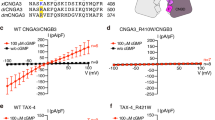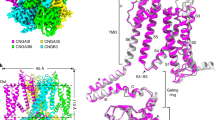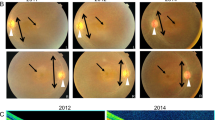Abstract
Achromatopsia is a congenital, autosomal recessively inherited disorder characterized by a lack of color discrimination, low visual acuity (<0.2), photophobia, and nystagmus. Mutations in the genes for CNGA3, CNGB3, and GNAT2 have been associated with this disorder. Here, we analyzed the spectrum and prevalence of CNGB3 gene mutations in a cohort of 341 independent patients with achromatopsia. In 163 patients, CNGB3 mutations could be identified. A total of 105 achromats carried apparent homozygous mutations, 44 were compound (double) heterozygotes, and 14 patients had only a single mutant allele. The derived CNGB3 mutation spectrum comprises 28 different mutations including 12 nonsense mutations, eight insertions and/or deletions, five putative splice site mutations, and three missense mutations. Thus, the majority of mutations in the CNGB3 gene result in significantly altered and/or truncated polypeptides. Several mutations were found recurrently, in particular a 1 bp deletion, c.1148delC, which accounts for over 70% of all CNGB3 mutant alleles. In conclusion, mutations in the CNGB3 gene are responsible for approximately 50% of all patients with achromatopsia. This indicates that the CNGB3/ACHM3 locus on chromosome 8q21 is the major locus for achromatopsia in patients of European origin or descent.
Similar content being viewed by others
Log in or create a free account to read this content
Gain free access to this article, as well as selected content from this journal and more on nature.com
or
References
Hess RF, Sharpe LT, Nordby K (eds): Night Vision: Basic, Clinical and Applied Aspects. Cambridge: Cambridge University Press, 1990.
Kohl S, Marx T, Giddings I et al: Total colorblindness is caused by mutations in the gene encoding the α-subunit of the cone photoreceptor cGMP-gated cation channel. Nat Genet 1998; 19: 257–259.
Kohl S, Baumann B, Broghammer M et al: Mutations in the CNGB3 gene encoding the β-subunit of the cone photoreceptor cGMP-gated channel are responsible for achromatopsia (ACHM3) linked to chromosome 8q21. Hum Mol Genet 2000; 9: 2107–2116.
Sundin OH, Yang JM, Li Y : Genetic basis of total colourblindness among the Pingelapese islanders. Nat Genet 2000; 25: 289–293.
Kohl S, Baumann B, Rosenberg T et al: Mutations in the cone photoreceptor G-protein alpha-subunit gene GNAT2 in patients with achromatopsia. Am J Hum Genet 2002; 71: 422–425.
Aligianis IA, Forshew T, Johnson S et al: Mapping of a novel locus for achromatopsia (ACHM4) to 1p and identification of a germline mutation in the alpha subunit of cone transducin (GNAT2). J Med Genet 2002; 39: 656–660.
Müller F, Kaupp UB : Signaltransduktion in Sehzellen. Naturwissenschaften 1998; 85: 49–61.
Wissinger B, Gamer D, Jagle H et al: CNGA3 mutations in hereditary cone photoreceptor disorders. Am J Hum Genet 2001; 69: 722–737.
Rojas CV, Maria LS, Santos JL, Cortes F, Alliende MA : A frameshift insertion in the cone cyclic nucleotide gated cation channel causes complete achromatopsia in a consanguineous family from a rural isolate. Eur J Hum Genet 2002; 10: 638–642.
Johnson S, Michaelides M, Aligianis IA et al: Achromatopsia caused by novel mutations in both CNGA3 and CNGB3. J Med Genet 2004; 41: e20.
Jägle H, Kohl S, Apfelstedt-Sylla E, Wissinger B, Sharpe LT : Manifestations of rod monochromacy. Col Res Appl 2001; 26: S96–S99.
Eksandh L, Kohl S, Wissinger B : Clinical features of achromatopsia in Swedish patients with defined genotypes. Ophthal Genet 2002; 23: 109–120.
Kellner U, Wissinger B, Kohl S, Kraus H, Foerster MH : Molecular genetic findings in patients with congenital cone dysfunction: mutations in the CNGA3, CNGB3, or GNAT2 genes. Ophthalmologe 2004; 101: 830–835.
Peng C, Rich ED, Thor CA, Varnum MD : Functionally important calmodulin binding sites in both N- and C-terminal regions of the cone photoreceptor cyclic nucleotide-gated channel CNGB3 subunit. J Biol Chem 2003; 278: 24617–24623.
Sheffield VC : The vision of typhoon lengkieki. Nat Med 2000; 6: 746–747.
Peng C, Rich ED, Varnum MD : Achromatopsia-associated mutation in the human cone photoreceptor cyclic nucleotide-gated channel CNGB3 subunit alters the ligand sensitivity and pore properties of heteromeric channels. J Biol Chem 2003; 278: 34533–34540.
Dryja TP, McGee TL, Reichel E et al: A point mutation of the rhodopsin gene in one form of retinitis pigmentosa. Nature 1990; 343: 364–366.
Stone EM, Lotery AJ, Munier FL et al: A single EFEMP1 mutation associated with both Malattia Leventinese and Doyne honeycomb retinal dystrophy. Nat Genet 1999; 22: 199–202.
Maugeri A, Flothmann K, Hemmrich N et al: The ABCA4 2588G>C Stargardt mutation: single origin and increasing frequency from South-West to North-East Europe. Eur J Hum Genet 2002; 10: 197–203.
Michaelides M, Aligianis IA, Ainsworth JR et al: Progressive cone dystrophy associated with mutation in CNGB3. Invest Ophthalmol Vis Sci 2004; 45: 1975–1982.
Trankner D, Jagle H, Kohl S et al: Molecular basis of an inherited form of incomplete achromatopsia. J Neurosci 2004; 24: 138–147.
Peng C, Rich ED, Varnum MD : Subunit configuration of heteromeric cone cyclic nucleotide-gated channels. Neuron 2004; 42: 401–410.
Wissinger B, Müller F, Weyand I et al: Cloning, chromosomal localization and functional expression of the gene encoding the α-subunit of the cGMP-gated channel in human cone photoreceptors. Eur J Neurosci 1997; 9: 2512–2521.
Gerstner A, Zong X, Hofmann F, Biel M : Molecular cloning and functional characterization of a new modulatory cyclic nucleotide-gated channel subunit from mouse retina. J Neurosci 2000; 20: 1324–1332.
Sidjanin DJ, Lowe JK, McElwee JL et al: Canine CNGB3 mutations establish cone degeneration as orthologous to the human achromatopsia locus ACHM3. Hum Mol Genet 2002; 11: 1823–1833.
Aguirre GD, Rubin LF : The electroretinogram in dogs with inherited cone degeneration. Invest Ophthalmol 1975; 14: 840–847.
Aguirre GD, Rubin LF : Pathology of hemeralopia in the Alaskan malamut dog. Invest Ophthalmol 1974; 13: 231–235.
Gropp KE, Szel A, Huang JC, Acland GM, Farber DB, Aguirre GD : Selective absence of cone outer segment beta 3-transducin immunoreactivity in hereditary cone degeneration (cd). Exp Eye Res 1996; 63: 285–296.
Acknowledgements
We thank all patients and family members for participating in this study, and Manfred Stuhrmann-Spangenberg, Jennifer Kemp, Karmen Trzupek, and Gert Matthijs for supplying us with patients and blood/DNA samples. We also thank Jochen Scholl, Martina Borghammer, Sabine Tippmann, and Eva Weber for excellent technical assistance. This work was supported by the following grants: Grant IB2 and Q1 from the Bundesministerium für Bildung und Forschung (01 KS 9602) and the Interdisziplinäres Zentrum für Klinische Forschung (IZKF) Tübingen to LTS and BW; a grant of the Schilling Stiftung to LTS; Grants SFB430/A5 and W: 1189/6-1 of the Deutsche Forschungsgemeinschaft to BW; Grant 32-065250.01 from the Swiss National Science Foundation to FLM; Grant DFGLo457,1–3 of the Deutsche Forschungsgemeinschaft to BL; a grant from the Foundation Fighting Blindness and Research to Prevent Blindness to RGW. CR: None.
Author information
Authors and Affiliations
Corresponding authors
Rights and permissions
About this article
Cite this article
Kohl, S., Varsanyi, B., Antunes, G. et al. CNGB3 mutations account for 50% of all cases with autosomal recessive achromatopsia. Eur J Hum Genet 13, 302–308 (2005). https://doi.org/10.1038/sj.ejhg.5201269
Received:
Revised:
Accepted:
Published:
Issue date:
DOI: https://doi.org/10.1038/sj.ejhg.5201269
Keywords
This article is cited by
-
S-cone contribution to oscillatory potentials in patients with blue cone monochromacy
Documenta Ophthalmologica (2024)
-
Achromatopsia: Genetics and Gene Therapy
Molecular Diagnosis & Therapy (2022)
-
Molecular and clinical characterization of Thai patients with achromatopsia: identification of three novel disease-associated variants in the CNGA3 and CNGB3 genes
International Ophthalmology (2021)
-
Naturally-occurring myopia and loss of cone function in a sheep model of achromatopsia
Scientific Reports (2020)
-
Molecular genetic analysis using targeted NGS analysis of 677 individuals with retinal dystrophy
Scientific Reports (2019)



